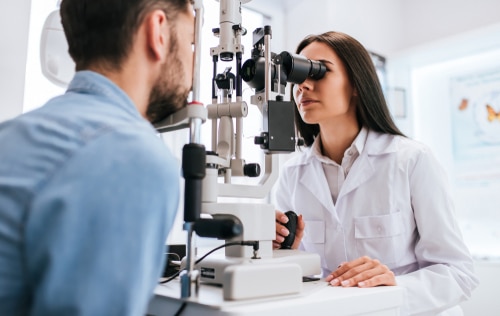
Astigmatism is a refractive error that occurs when you have an irregularly shaped cornea. Typically, a normal cornea is shaped like a basketball, but in those with astigmatism, it is shaped more like a football.
As a result, the cornea doesn’t focus light at the back of your retina as it should. Blurred vision, eyestrain, and frequent headaches are some of the most common symptoms of astigmatism.
The refractive error can also cause distorted vision, squinting, and poor night vision. Keep reading to learn how you can manage astigmatism!
Astigmatism Treatment
Your eye doctor can help you manage your astigmatism symptoms through treatment. Treating astigmatism significantly enhances your eye comfort and vision clarity.
There are various options for correcting astigmatism, including:
Glasses
Prescription glasses are the easiest way to fix astigmatism. Glasses work by compensating the irregular curvature of astigmatism with a lens curved in the opposite direction of your cornea.
Doing this effectively offsets the distortion. With the right prescription, you’ll be able to see without headaches, blurriness, squinting, and other astigmatism symptoms.
Contact Lenses
Similar to glasses, contact lenses can also be used to improve astigmatism symptoms. Eye doctors often prescribe specially designed contacts such as toric lenses for astigmatism patients.
Contact lenses also correct astigmatism by counteracting the irregular curvature of your cornea. These contacts can further correct farsightedness or nearsightedness simultaneously.
Contact lenses have a thicker bottom to prevent them from rotating out of alignment, ensure they are positioned correctly on your eye, and maintain good vision.
LASIK
LASIK can provide the perfect solution if you’re tired of relying on your glasses or contacts. Many patients choose LASIK for astigmatism because it’s a permanent vision correction procedure that eliminates the need for glasses or contacts.
Plus, laser eye surgery is very safe and has little downtime. Your LASIK surgeon makes a tiny incision into your cornea to create a flap during the procedure.
Then, your ophthalmologist will reshape your cornea. Reshaping the cornea allows light entering your eyes to focus appropriately on the retina.
This alleviates astigmatism symptoms and enables you to experience clear vision.
PRK
PRK surgery is usually a great option if you don’t qualify for LASIK. For instance, your eye doctor may recommend PRK if your corneas are too thin.
The vision correction procedure produces comparable outcomes to LASIK when correcting astigmatism. Your ophthalmologist starts by completely removing the epithelium or outermost part of the cornea.
Next, your eye surgeon will reshape your cornea with a laser, similar to LASIK, changing how your eye focuses light. Finally, your eye doctor will place a bandage contact lens over your cornea to protect it as it heals and regrows.
Like LASIK, you will be able to significantly reduce your dependence on contacts or glasses post-PRK.
Astigmatism Correction Specialists
Astigmatism can considerably affect your vision and quality of life when left untreated. But you don’t have to live with poor vision.
The eye doctors at Colorado Eye Consultants have extensive experience correcting astigmatism. They’ll determine your level of astigmatism and match you with the best treatment option to ensure you see your absolute best
Want to find out how you can manage your astigmatism? Schedule an appointment at Colorado Eye Consultants in Littleton, CO, today!

